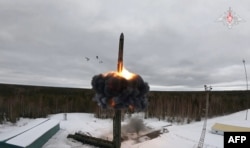I'm Steve Gutterman, the editor of RFE/RL's Russia/Ukraine/Belarus Desk.
Welcome to The Week In Russia, in which I dissect some of the key developments in the country and in its war against Ukraine, and some of the takeaways going forward. To subscribe, click here.
Russia's use of what President Vladmir Putin said was a new intermediate-range missile against Ukraine was all about signaling -- "a political strike not a military one," as one analyst put it.
Here are some of the key developments in Russia over the past week and some of the takeaways going forward.
'Not For Military Value'
On the surface, it was a military attack on Ukraine. But Russia's launch of what President Vladimir Putin described as a new intermediate-range missile was all about messaging, with most of the signals aimed squarely at Washington and the West.
In televised remarks after the November 21 strike targeting the city of Dnipro, Putin said it was part of Moscow's response to Ukrainian attacks with U.S.-supplied ATACMS and British-supplied Storm Shadow missiles, which followed reports that those countries had given Kyiv permission to use such systems to hit Russian territory. And he said Russia had the right to target military facilities in countries that allow Kyiv to use their weapons for this purpose.
"In short, this was a political strike not a military one," Mick Ryan, a retired Australian Army major general and a senior fellow at the Sydney-based Lowy Institute think tank, wrote on X, formerly Twitter.
The ballistic missile strike was part of a broader attack on Dnipro, where Ukrainian authorities said three people were wounded. They said the attack damaged an industrial facility and a rehabilitation center for the handicapped, where photos showed broken windows, a collapsed ceiling, and debris scattered across floors.
Fabian Hoffman, a defense expert and doctoral research fellow at the University of Oslo, told the Kyiv Independent that "this strike is not for military value, this is purely, purely for political purposes."
Here's a look at what Putin was probably trying to achieve.
'A Different Signal'
Since Putin ordered the full-scale invasion of Ukraine in February 2022, he and other Russian officials -- and state-controlled media -- have repeatedly used the potential threat of a nuclear attack to try to frighten the West and deter the United States and Europe from sending weapons to Kyiv.
This nuclear messaging has been so frequent, in fact, that Russia may be running out of sabers to rattle: The Kremlin may be concerned that it is seen as letting its "red lines" be crossed without consequence.
Putin "may perceive that his mentioning nuclear weapons, having done so frequently, is of diminishing value in getting his message across about what he sees as NATO interference in his genocidal war," Ryan wrote. "He needed a different signal to Washington, and he chose to do so with a different kind of weapon."
Putin has been raising the specter of a nuclear strike since long before the full-scale invasion of Ukraine. But there are plenty of reasons for Russia to refrain from using its atomic arsenal, including questions about effectiveness in the war on Ukraine and the blowback Moscow could face from countries around the world, including China, India, and countries of the Global South.
No 'Significant Inflection'
Nonetheless, the nuclear messaging was by no means missing: In his address, Putin said that "in this case" the missile -- which he called Oreshnik (Hazel) and the Pentagon said was based on an existing model, the RS-26 or Rubezh -- had a non-nuclear payload.
"It's the kind of signaling you engage in when you can't, in fact, escalate in the way you've been threatening," Ruth Deyermond, senior lecturer in the Department of War Studies at King's College London, wrote of the November 21 missile strike.
Like previous words and actions, including a change in the Russian nuclear doctrine this month that included wording that seemed aimed to give Putin freer rein to use atomic weapons if he decides to do so, the missile strike said little about Russia's actual intentions.
"Neither the Oreshnik ballistic missile strike nor Putin's November 21 statement represent a significant inflection in Russian strike capabilities or likeliness to use a nuclear weapon," the U.S.-based Institute for the Study of War said in a thread on X.
Biden, Trump, Ukraine, Europe
With U.S. President Joe Biden on his way out and less than two months remaining before President-elect Donald Trump returns to the White House, Putin may hope the missile "test," as he called it, would do double duty, warning Biden against major moves to strengthen Kyiv in his remaining weeks in office and encouraging Trump -- whose repeated claims that he would quickly end the war have generated expectations of a push for peace -- to roll back U.S. support for Ukraine.
While the United States may be the main target of Russia's signaling, the strike may also have been aimed to sow fear in Ukraine and cause concern in Europe at a time when Trump's upcoming presidency is raising questions not only about levels of U.S. support not only for Ukraine, but about its relationship with NATO and its solidarity with the European Union.
Putin "isn't only messaging Washington D.C. here. He has used a weapon with a range of over 5,000 kilometers, which could therefore be used against almost any target in Europe and the United Kingdom," Ryan wrote. "This is a message to Europe, not only about their support for Ukraine, but also about Russia's capacity and willingness to influence policy related to defense and security well beyond Ukraine."
That's it from me this week.
If you want to know more, catch up on my podcast The Week Ahead In Russia, here on our site or wherever you get your podcasts (Apple Podcasts, Spotify, Pocket Casts).
Yours,
Steve Gutterman









